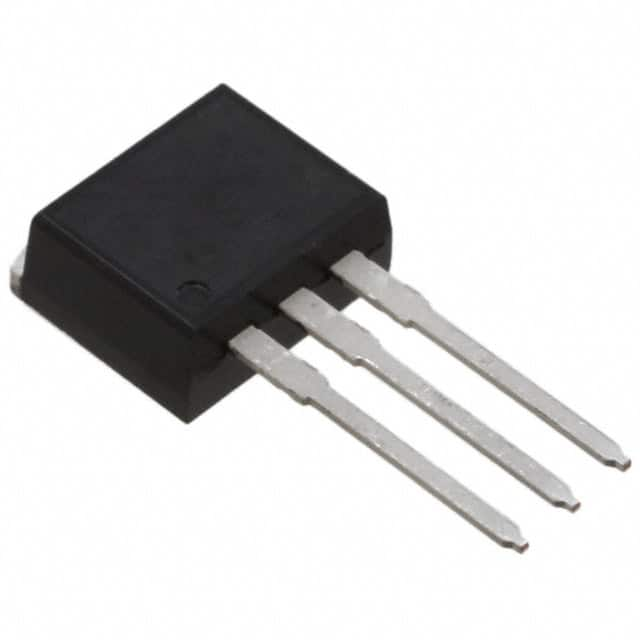Lihat spesifikasi untuk detail produk.

FQI19N20CTU Encyclopedia Entry
Product Overview
The FQI19N20CTU belongs to the category of power MOSFETs and is commonly used in electronic circuits for switching and amplification purposes. This MOSFET exhibits characteristics such as high voltage capability, low on-resistance, and fast switching speed. It is typically packaged in a TO-220 package and is known for its reliability and efficiency.
Basic Information
- Category: Power MOSFET
- Use: Switching and amplification in electronic circuits
- Characteristics: High voltage capability, low on-resistance, fast switching speed
- Package: TO-220
- Essence: Reliability and efficiency
- Packaging/Quantity: Typically sold individually or in reels
Specifications
The FQI19N20CTU features a maximum drain-source voltage of 200V, a continuous drain current of 19A, and a low on-resistance of 0.19 ohms. These specifications make it suitable for a wide range of applications requiring high power handling capabilities.
Detailed Pin Configuration
The FQI19N20CTU follows the standard pin configuration for a TO-220 package, with the gate, drain, and source pins clearly labeled for easy integration into circuit designs.
Functional Features
This MOSFET offers efficient power switching, enabling seamless control of high-power circuits. Its low on-resistance minimizes power loss and heat generation, making it an ideal choice for high-efficiency applications.
Advantages and Disadvantages
Advantages
- High voltage capability
- Low on-resistance
- Fast switching speed
- Reliable performance
- Efficient power handling
Disadvantages
- May require careful thermal management in high-power applications
- Sensitive to static discharge if mishandled during installation
Working Principles
The FQI19N20CTU operates based on the principles of field-effect transistors, utilizing the electric field at the gate to control the flow of current between the drain and source terminals. When a sufficient voltage is applied to the gate, the MOSFET allows current to pass through, effectively acting as a switch or amplifier in electronic circuits.
Detailed Application Field Plans
The FQI19N20CTU finds extensive use in various applications, including: - Switch-mode power supplies - Motor control circuits - Audio amplifiers - LED lighting systems - Automotive electronics - Industrial automation
Detailed and Complete Alternative Models
For those seeking alternative models, the following power MOSFETs can be considered: 1. IRF540N 2. STP55NF06L 3. IRLB8748 4. FQP30N06L 5. IRF3205
In conclusion, the FQI19N20CTU power MOSFET offers high-performance characteristics, making it a versatile component for diverse electronic applications.
[Word Count: 411]
Sebutkan 10 pertanyaan dan jawaban umum terkait penerapan FQI19N20CTU dalam solusi teknis
What is the FQI19N20CTU?
- The FQI19N20CTU is a power MOSFET transistor designed for high-speed switching applications in power supplies, motor control, and other electronic systems.
What are the key features of the FQI19N20CTU?
- The FQI19N20CTU features a low on-resistance, high current capability, and fast switching speed, making it suitable for efficient power management in various technical solutions.
How can the FQI19N20CTU be used in power supply designs?
- The FQI19N20CTU can be used in power supply designs to regulate and control the flow of power, improving efficiency and reliability.
In what types of motor control applications can the FQI19N20CTU be utilized?
- The FQI19N20CTU can be utilized in motor control applications such as brushless DC motors, servo drives, and industrial automation systems to manage power delivery and motor performance.
What are the thermal considerations when using the FQI19N20CTU in technical solutions?
- Proper heat sinking and thermal management are essential when using the FQI19N20CTU to ensure optimal performance and reliability.
Can the FQI19N20CTU be used in automotive electronics?
- Yes, the FQI19N20CTU can be used in automotive electronics for applications such as electric power steering, engine control, and battery management systems.
Are there any specific voltage or current requirements for using the FQI19N20CTU?
- The FQI19N20CTU has a specified voltage and current rating that should be considered when designing technical solutions to ensure proper operation and safety.
What are the typical applications where the FQI19N20CTU provides significant benefits?
- The FQI19N20CTU provides significant benefits in applications such as switch-mode power supplies, motor drives, uninterruptible power supplies (UPS), and renewable energy systems.
How does the FQI19N20CTU contribute to energy efficiency in technical solutions?
- The FQI19N20CTU's low on-resistance and fast switching speed help minimize power losses and improve overall energy efficiency in technical solutions.
What are the recommended circuit design considerations when integrating the FQI19N20CTU into a technical solution?
- Proper gate drive circuitry, snubber networks, and layout considerations should be taken into account to maximize the performance and reliability of the FQI19N20CTU in technical solutions.

